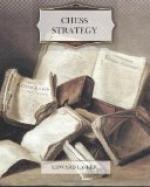and 98. In the one case the chain of Black pawns is broken by the absence of K Kt P, in the other of the Q Kt P. The absence of the KKt pawn can lead to serious consequences in the middle game, because of the weakness of Black’s KB3 and KR3 (compare Diagram 90); it can, however, hardly become awkward in the end-game, as the pawns on the B and R files are within the protecting reach of their King.
--------------------------------------- 8 | #R | | | #Q | | #R | #K | | |---------------------------------------| 7 | #P | | #P | #B | #B | #P | #P | #P | |---------------------------------------| 6 | | | #P | #P | |#Kt | | | |---------------------------------------| 5 | | | | | | | | | |---------------------------------------| 4 | | | |^Kt | ^P | | | | |---------------------------------------| 3 | | |^Kt | ^Q | | | | | |---------------------------------------| 2 | ^P | ^P | ^P | | | ^P | ^P | ^P | |---------------------------------------| 1 | ^R | | ^B | | | ^R | ^K | | --------------------------------------- A B C D E F G H
Diag. 98
On the other hand, the absence of the Q Kt P is of no consequence for the middle game. There is nothing behind it which could invite an attack. The QRP and QBP, however, are very weak for the end-game, as they are quite out of reach of the King (compare Game No. 19). I do not wish to imply that Black should have avoided the exchange at his QB3 at all cost; such an exchange has always the compensating advantage of opening a file for the Rooks, which advantage often means a favourable middle game, as will be readily understood. Further, it is often possible to get rid of the weak QRP by pushing it on, and eventually compelling the exchange of the opposing Kt P, an exchange which can usually be enforced if the Rooks have occupied the open Kt file. The pawn itself is often useful at B 3, in that it can support the advance of P-Q 4 in the centre, should it be desired, or it can, by pushing on, be brought to exercise further pressure on the opposing Kt P.
The break-up of the pawn position on the Q side can become awkward in the end-game and sometimes in the middle-game when the pawns can be attacked, and pieces brought to bear on the Queen’s side without leaving the King’s side denuded of forces.
This will be illustrated by the position in Diagram 99.
--------------------------------------- 8 | #R | | #B | | | #R | #K | | |---------------------------------------| 7 | #P | | #P | | | #P | #P | #P | |---------------------------------------| 6 | | | #P | | | | | | |---------------------------------------| 5 | | | | | | | | | |---------------------------------------| 4 | | | | | | | | | |---------------------------------------| 3 | | | | | | ^B | | | |---------------------------------------| 2 | ^P | | ^P | | | ^P | ^P | ^P | |---------------------------------------| 1 | ^R | | | | | ^R | ^K | | --------------------------------------- A B C D E F G H
Diag. 99




